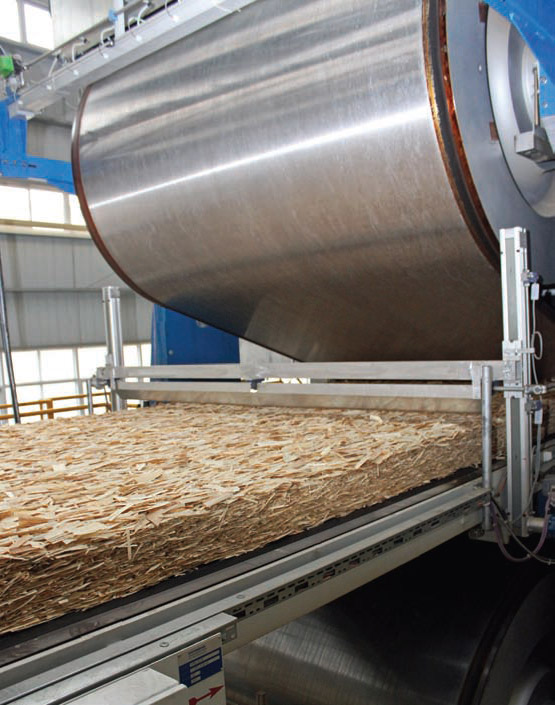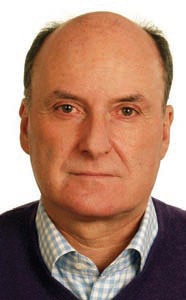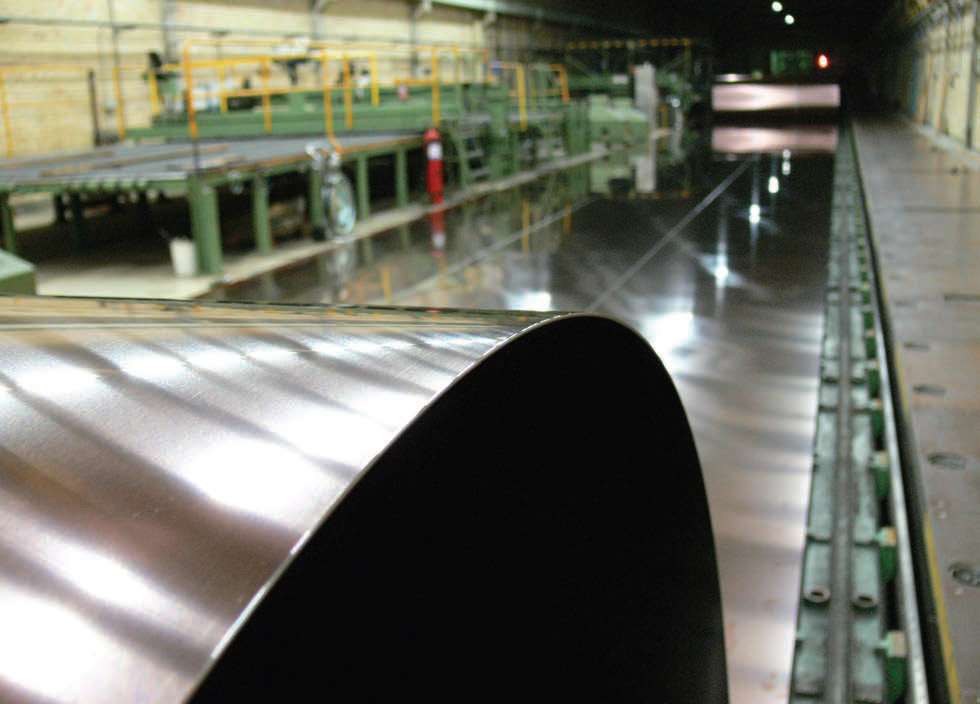Jörg Kaufmann: Belting it out
8 December 2016Jörg Kaufmann is global product manager at Sandvik Surface Solutions, in charge of belts for continuous presses. WBPI asked him about issues and prospects for Sandvik and other German-based players in the industry.
Few companies can have played a more central role in the development of the wood based panel industry than Sandvik. Not least of its contributions has been the introduction of the steel belt to the industry.
About half a century ago, Sandvik designed and built the first successful continuous double belt press. Today, it is one of only two major producers of endless stainless steel belts worldwide. About 20-30% of the company's belts are supplied to press manufacturers to go with new machines, while the rest are ordered by the panel-making industry.
Jörg Kaufmann is the product manager for Sandvik’s wood based panel belts. Aged 57, he has been 27 years with the company; the last six in his present position. He is based at the Sandvik Surface Solutions works at Ennepetal, between Dortmund and Cologne" not far from the German border with Holland. Since almost every supplier of press systems for wood based panels is a Sandvik customer he seems excellently placed to give a global view of the industry and the market. We asked him about the current state of health of the European wood panels market.
"Economic conditions in Europe remain challenging," he says, adding that there is no reason to be pessimistic. "Overall the markets are growing. There are one or two exceptions, hardboard being one example, but one can say that the industry is faring well in the face of a number of challenges such as the availability of raw materials and unhelpful legislation.
As ever, the number one challenge for any manufacturer these days is maintaining maximum productivity. You could summarise the situation overall by saying that growth is slow but steady – and that is reflected in the market for steel belts."
The market means of course customers. In speaking of how the needs of his customers had changed, Mr Kaufmann echoed the sentiments presented in several of these articles: customers want more than just machinery now.
"Any downtime can prove extremely costly. So customers are looking for more than just a belt supplier; they want to know that any belt related production issues will be resolved as quickly and professionally as possible.
"There is more competition in our market these days. Just as our customers have to create differentiation between themselves and lower-cost producers in terms of product quality, so we have to set ourselves apart through our service and support capabilities.
"The most significant change in the market itself has been the demand for thinner boards. This is widespread. Manufacturers are aiming for a product with a surface quality that can be taken from the press without any further treatment and this requires a belt with a very high-quality finish.
"Thin boards also require less time on the press to ensure that they not do not over-cure and this, together with demand for ever higher productivity, means belt speeds can be up to 2000mm/sec." This of course puts higher stresses on the belts, demanding higher expertise in their making.
"Finally, the critical importance of the belt surface makes repairs to them more challenging. The impact of an imperfect repair will be obvious on a 1.6mm board, so we have had to develop new repair technologies that are as close to invisible as it’s possible to get." If you want to see that working in the flesh, go to Ligna, says Mr Kaufmann. "This will be one of our key messages at Ligna 2017."
And quality, the constant thread in this report, is something that no German manufacturer dare relinquish. Once again Mr Kaufmann, unprompted, echoes the theme.
"Our core offering is the quality of engineering that goes into producing high performance steel belts for wood based panel production. Our raw material – cold-rolled steel belt – has to undergo a whole series of processes before it can be used on a press, including levelling, longitudinal welding, heat-treating and grinding and every stage has to be measured and documented. Our expertise in this aspect of belt production is unparalleled.
"In terms of innovation, our major developments have been in the field of service support. Our QuickDisc tool is used to cut out damaged areas of a belt and create replacement discs from the spare sections we supply with every belt. This is a tool that has been on the market for many years now but we will be introducing a new, more efficient model in 2017.
"Another exciting innovation has been our QuickAnnealer tool, used to enhance the quality of belt repairs," says the manager.
"Applying a concentrated heat of up to 600°C to the weld area improves and hardens the micro-structure of the weld and this can have major benefits in the production of sensitive products after a repair.
"Service support is critical these days.
It is the key differentiator as far as we are concerned. Our marketing message is 'Premium products, premium productivity’ – and this summarises the benefits of our service offering: we have the tools and expertise to help you deliver products of the highest quality, and achieve maximum productivity too," says Mr Kaufmann.
"An important part of this is our global service organisation. We have local service engineers, people on the ground who understand local issues and speak the language. These are our front line support teams. They’re also supported by highly qualified global technicians who can provide specialist on-site support at short notice. Between them, these teams are focused on helping manufacturers gain maximum return on investment through planned maintenance and a rapid response to any belt issues.
"In-house service capabilities are equally important. That’s the reason we developed our QuickTool range, to give in-house personnel the ability to repair or maintain their belts without having to call us in. This means downtime is kept to the absolute minimum," he explains.
We’re also increasing our focus on inhouse training, passing on key skills to the people who are directly responsible for press repair and maintenance. We run these courses all over the world, either from our regional offices or, if they prefer it, we can run them at the customer’s own site."
And of course, automation and digital data gathering are transforming things.
"The data gathered by machine builders can be invaluable in terms of problem solving.
There are systems that control, monitor and record the tracking of the belt, the pressure chain mat and the product itself, and this is something we can use to identify the source of any production inconsistencies.
"This is a good example of how our close partnership with original equipment manufacturers works to the benefit of board producers," says Mr Kaufmann.
By 'original equipment manufacturers’ he means the twin giants of panel press lines, Dieffenbacher and Siempelkamp, both of whom use Sandvik belts in their presses.
How does he see the future, both long and short term, for manufacturing in Germany? In view of labour costs, Euro problems and politics, and all the associated costs of manufacturing in a highly-developed and expensive part of the world, can the country maintain its reputation for the highest-quality machinery, delivered at a price consumers can afford?
"The fact that the world’s two largest original equipment manufacturers are located here makes Germany a focal point of the wood based panel industry," he says. "The success of both companies is founded on the delivery of high quality solutions and, for the short to medium future at least, we cannot see any challenge to their position. We look forward to working with them in what we think of as a 'productivity partnership'".
And finally, no interview can be satisfactorily completed without some industry gossip. It is well known that Sandvik AB, the Swedish parent company whose products span tooling, mining and construction is hoping to sell off Sandvik Process Systems, which is the steel belt side of the business. Mr Kaufmann volunteers some information.
"We are aware of some of the rumours that have been suggested by third parties so let me put this straight. Any change of ownership will have no impact on our ability to support customers through market-leading products and world class service, either now or in the future.
"Sandvik Process Systems has operated as a business in its own right since 1969, with its own representation the world over, and we will continue to work to the same high standards even though our overall ownership – and our company name – may change. We are the largest steel belt supplier in the world today, and universally recognised as the market leader. Steel belts have always been, and will remain, our core business."
You can be reassured, it seems. Your belts are secure: No need for braces!


